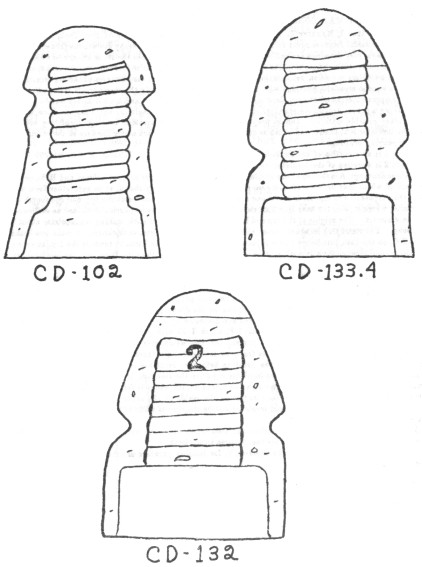The Rim Embossed PAT'D
Reprinted from "INSULATORS - Crown Jewels of the Wire", January 1979, page 6
(The following article was sent in by Tom G. Moulton, Ballston Lake, New York)
Shown in this display are the only three C.D.'s in which this embossing is now
known to exist. Two of the pieces, while not common, have been seen before,
while the third is being displayed here for the first time. Let's examine each
of them:

C.D. 102 -- the Pony -- This insulator has been found in more than one
place in the Country, but has been found only very sparsely. Probably less than
fifteen could be found in collections across the Country. To date, all of the
pieces have been found in aqua glass, which appears to be of quality
manufacture. Note that the piece is a product of a three piece mold.
C.D. 133.4 -- the bullet shaped Signal -- Again, this piece is not considered, usually, to
be exceptionally Rare. It has been found in limited quantities in locations
across the Country. This particular piece, however, is the only known Cobalt
Blue specimen. Note that the piece is also formed in a three piece mold and
seems to be made of quality glass. The majority of the other insulators which
have been found in this C.D. carry the December 19, 1871 Hemingray patent date
embossed on the crown.
C.D. 132 -- the larger aqua Signal -- As of this writing, this
piece is a one of a kind and is an extraordinary find. As with the other pieces,
it was manufactured in a three piece mold and seems to be of quality glass. All
other C.D. 132 insulators carry the embossed Hemingray patent date (December 19,
1871) or Patent applied for on the front dome, with a large 2 embossed on the
rear dome.
The significance of this particular piece is the large 2 embossed on
the dome. This would appear to link Hemingray to the rim embossed PATD
embossing. Many assumptions to this end have been made in the past because of
the similar designs of the C.D. 133.4, but nothing concrete has been found to
link the two.
If this piece provides the link, it is reasonable to wonder why
Mr. Milholland lists no Pony embossed with the 1871 date. It would seem that if
the others were made in this fashion, the Pony would have been as well. I should
point out that Messrs. Cranfill and Kareofelas did, in fact, list such a piece
in "The Collectors Guide for Glass Insulators *Revised Edition*"
Copyright 1967, but the listing seems to have stopped there.
It is the writer's
opinion that these pieces were, in fact, probably experimental and probably the
first to be made with the experimental press which was patented in 1871.
However, it is interesting to note that the drawings for the patent seem to show
only a two piece mold. Was the press mold changed? Were these pieces made by
Hemingray? Well, we probably will never know for sure; but the large 2 embossed
on the dome of the C.D. 132 would seem to offer conclusive proof of a direct
Hemingray relationship.
| 